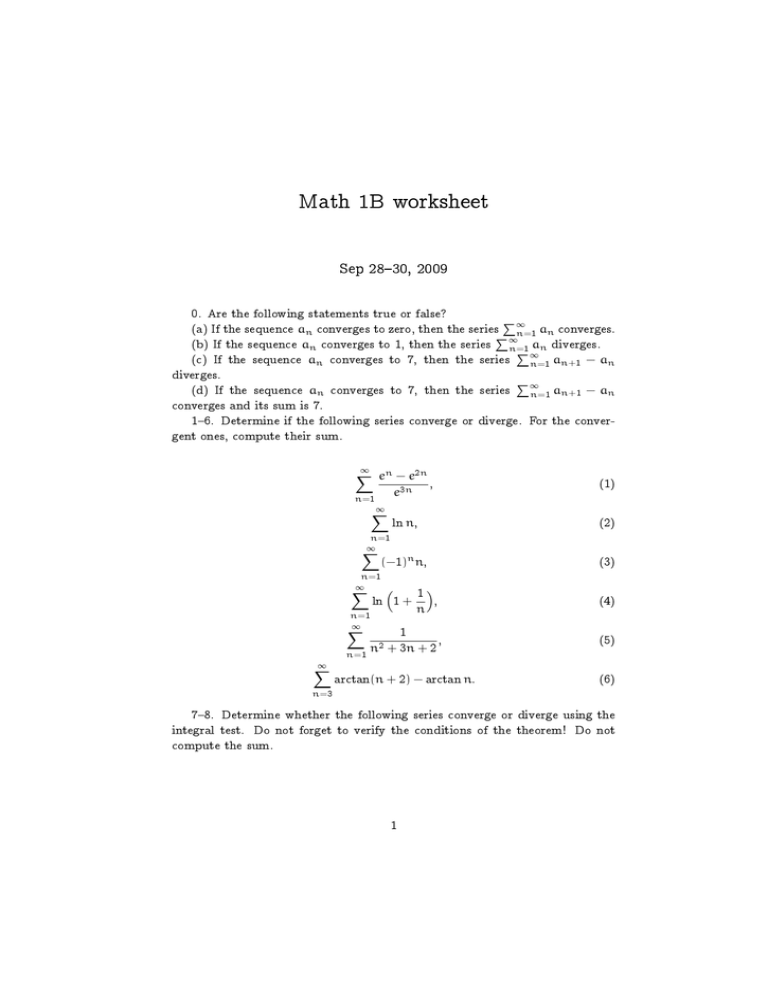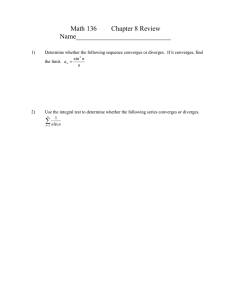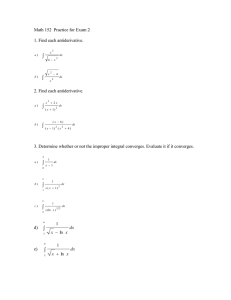Math 1B worksheet Sep 28{30, 2009
advertisement

Math 1B worksheet
Sep 28{30, 2009
0. Are the following statements true or false?
P
(a) If the sequence an converges to zero, then the seriesP ∞
n=1 an converges.
(b) If the sequence an converges to 1, then the series ∞
a diverges.
n=
P1 ∞ n
(c) If the sequence an converges to 7, then the series n=1 an+1 − an
diverges.
P
(d) If the sequence an converges to 7, then the series ∞
n=1 an+1 − an
converges and its sum is 7.
1{6. Determine if the following series converge or diverge. For the convergent ones, compute their sum.
∞
X
en − e2n
,
e3n
n=1
∞
X
ln n,
(2)
(−1)n n,
(3)
n=1
∞
X
n=1
∞
X
1
,
(4)
1
,
+ 3n + 2
(5)
ln 1 +
n=1
∞
X
∞
X
n=1
(1)
n2
n
arctan(n + 2) − arctan n.
(6)
n=3
7{8. Determine whether the following series converge or diverge using the
integral test. Do not forget to verify the conditions of the theorem! Do not
compute the sum.
1
∞
X
n2
,
en
n=3
∞
X
1
n2 − 1
n=2
(7)
.
P
(8)
1
9. Consider the series ∞
n=1 an , where an = n2 +n .
(a) Prove that the series converge and calculate its sum s.
(b) Let sn be the sum of the rst n terms of the series and put rn =
s − sn . Estimate rn from above and from below using remainder estimate for
the integral test.
(c) Find a formula for rn and verify explicitly that the estimates obtained
in (b) hold.
R∞ 2
P
2
10. Show that the series ∞
n=1 sin (πn) converges, but the integral 1 sin (πx) dx
diverges. Does this contradict the integral test?
100∗ Find a formula for the sequence
sm =
m
X
n=1
Does the series
P∞
n=1
sin n converge?
2
sin n.
Hints and answers
0. (a) False; consider an = n1 for a counterexample
(b) True by Divergence Test
P
(c,d) Both are false. We have Sm = m
n=1 (an+1 − an ) = am+1 − a1 (telescoping series); then limm→∞ Sm = 7 − a1 .
1. We have
X
∞
∞
∞
X
X
en − e2n
−2n
−n
=
e
−
e
.
e3n
n=1
n=1
n=1
Both series in RHS are geometric series, but they start from n = 1 instead of
n = 0. They both converge because |p| < 1; to compute the sum of the rst
series, we subtract and add the 0th term:
∞
X
n=1
−2n
e
∞ X
1 n
=
e2
n=1
∞ X
1
e−2
1 n
=
−
1
+
=
.
= −1 +
e2
1 − e−2 1 − e−2
n=0
The second series is calculated similarly.
e−2
e−1
Answer: 1−e
−2 − 1−e−1 .
2. Apply the Divergence Test: limn→∞ ln n = +∞.
Answer: Diverges.
3. Apply the Divergence Test: limn→∞ (−1)n n does not exist.
Answer: Diverges. P
1
4. Use that ln 1 + n1 = ln(n + 1) − ln n. Then m
n=1 ln 1 + n = ln(m+ 1).
Answer: Diverges.
1
1
1
5. Use that n2 +31n+2 = (n+1)(n+
2) = n+1 − n+2 .
Answer: 12 .
6. We may compute
m
X
arctan(n + 2) − arctan n
n=3
= − arctan 3 − arctan 4 + arctan(m + 1) + arctan(m + 2)
and then take the limit as m → ∞.
Answer: − arctan 3 − arctan 4 + π.
7. Use f(x) = x2 e−x ; it Ris decreasing because f 0 (x) 6 0 for x > 3 and f(x) is
nonnegative. The integral 3∞ f(x) dx converges, say, by explicit antiderivative
computation.
Answer: Converges.
3
because f 0 (x) 6 0 for x > 2
8. Use f(x) = x21−1 ; it is nonnegative, decreasing
1
x−1
and has an antiderivative F(x) = 2 log x+1 . This antiderivative has a nite
limit (zero) as x → ∞; therefore, the integral converges;
Answer: Converges.
1
1
1
9. Using that an = n(n+
1) = n − n+1 , we get
sn = 1 −
1
n+1
, s = lim sn = 1, rn =
n→∞
1
n+1
.
Now, put f(x) = x21+x ; it is nonnegative and decreasing
(since f 0 (x) 6 0 for
x
x > 1) and has an antiderivative F(x) = ln x+1 . We then have the remainder
esimates
Z∞
Z∞
f(x) dx 6 rn 6
f(x) dx,
n+1
which turn into
ln
n
n + 2
6
n+1
1
n+1
6 ln
n + 1
n
.
The rst of these two inequalities, when exponentiated, becomes
1
e n+1 > 1 +
1
n+1
,
which is a special case of the inequality
ex > 1 + x
true for all real x. The second inequality can be rewritten is
1
e− n+1 > 1 −
1
n+1
,
which is again a special case of ex > 1 + x.
10. The series consists of all zeroes, so it converges to zero. The integral
diverges because the limit of the antiderivative as x → +∞ is innite. (To prove
that, use Squeeze Theorem.) However, this does not contradict the integral test
because the function sin2 (πx) is not decreasing.
100. Multiply by sin 12 and use that sin n sin 21 = 12 cos n− 21 − cos n+ 12 .
Answer: sm = 2 sin1(1/2) (cos(1/2) − cos(m + 1/2)); diverges.
4




